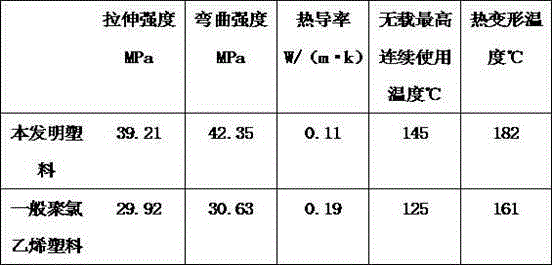Modified heat-resistant plastic
A modified and heat-resistant technology, which is applied in the field of modified heat-resistant plastics, can solve the problems of physical and mechanical properties degradation, poor stability, and small branching degree, and achieve improved heat resistance, low cost, and enhanced anti-friction and wear resistance performance effect
- Summary
- Abstract
- Description
- Claims
- Application Information
AI Technical Summary
Problems solved by technology
Method used
Image
Examples
Embodiment Construction
[0011] A modified heat-resistant plastic, the modified heat-resistant plastic is made of the following components in parts by weight: 45 parts of polyvinyl chloride resin, 32 parts of acrylic resin, 10 parts of aluminum powder, 6 parts of modified glass fiber, hard 1 part of calcium fatty acid, 3 parts of dispersant, 2 parts of heat stabilizer, 1 part of plasticizer.
[0012] Further, the aluminum powder is calcined aerobically at 200°C.
[0013] Further, the dispersant is sodium hexametaphosphate.
[0014] Further, the heat stabilizer is lead dibasic phosphite.
[0015] Further, the plasticizer is citrate.
[0016] Further, the manufacturing method of the modified glass fiber is as follows: soak the glass fiber in 0.5-1% concentration of silane coupling agent for 2-3 hours at 65-70°C, add sodium carboxymethyl cellulose, heat To 85-90°C for 1-1.5 hours, filter and dry.
[0017] A method for making a modified heat-resistant plastic, comprising:
[0018] 1) Weigh by weight,...
PUM
| Property | Measurement | Unit |
|---|---|---|
| glass transition temperature | aaaaa | aaaaa |
Abstract
Description
Claims
Application Information
 Login to View More
Login to View More - R&D
- Intellectual Property
- Life Sciences
- Materials
- Tech Scout
- Unparalleled Data Quality
- Higher Quality Content
- 60% Fewer Hallucinations
Browse by: Latest US Patents, China's latest patents, Technical Efficacy Thesaurus, Application Domain, Technology Topic, Popular Technical Reports.
© 2025 PatSnap. All rights reserved.Legal|Privacy policy|Modern Slavery Act Transparency Statement|Sitemap|About US| Contact US: help@patsnap.com

